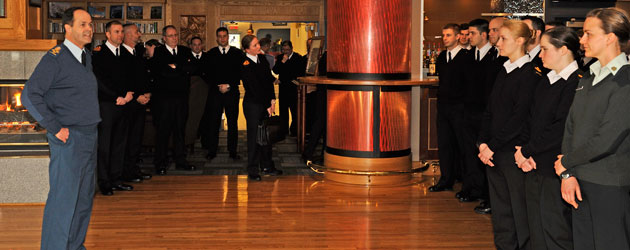
CDS addresses the next generation of leaders
Chief of the Defence Staff, Gen Tom Lawson chats with students and staff at Venture, The Naval Officer Training Centre Gun Room.

Chief of the Defence Staff, Gen Tom Lawson chats with students and staff at Venture, The Naval Officer Training Centre Gun Room.
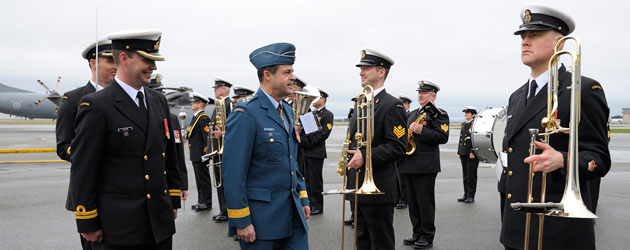
Lt(N) Matthew Clark, Director of Music, accompanies Chief of the Defence Staff, Gen Tom Lawson, as he inspects the Naden Band of the Royal Canadian Navy on his arrival at 443 Maritime Helicopter Squadron.
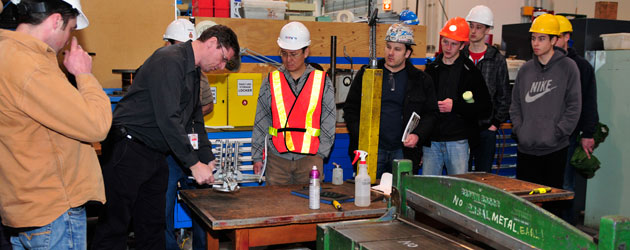
Al Hall, work centre manager electrical gives 24 Camosun College students a tour of Fleet Maintenance Facility Cape Breton's electrical shop so they can see where their electrical work relates to the ships.
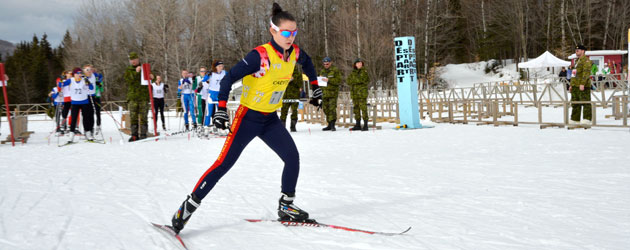
Luisa Tsang of Team British Columbia gets a good start during the Youth 7.5 km Pursuit at the National Cadet Biathlon Championships in Valcartier, QC.

[caption id="attachment_3535" align="alignnone" width="300"] The new hangar for 443 Maritime Helicopter Squadron is progressing on schedule and should be ready to house squadron personnel and equipment next year.[/caption] Beyond the window of Maj Donald Leblanc’s office chaos has developed. The 443 Maritime Squadron Air Reserve Flight Commander has a clear view of the new facility as it slowly grows from an empty clearing to a completed building. He can hear it to. “It’s very busy all the time, and quite loud,” he says. “It used to be you’d hear aircraft take off once in a while, but now it’s constant work and noise.” Despite the cacophony of construction, Maj Leblanc says squadron members are excited to move into a modern facility next year. “We can see the hangar get closer to completion every day. It’s a big project and big step for 443 Squadron,” he says. Within the one building – 20,000 square metres and three stories high – will be offices, workshops and three hangars bays to house nine Sikorsky CH-148 Cyclone helicopters, the eventual replacement of their six Sea Kings. It’s also being constructed to “Post-Disaster Standards” to withstand a major disaster such as an earthquake. “We’ve got the walls of the building anchored right into the bedrock under the site,” says John Knappett, President of Knappett Construction. “If anything happens this building isn’t going anywhere. It’s completely solid.” At any time there are about 200 people involved in the hangar’s construction. Knappett Construction, the general contracting firm, is responsible for much of the concrete work and civil engineering, while dozens of speciality contractors such as electricians, plumbers, roofers, and steel workers are subcontracted for the trades work. Knappett and his company have done work for the Canadian Forces before and feel it’s important to keep a healthy...
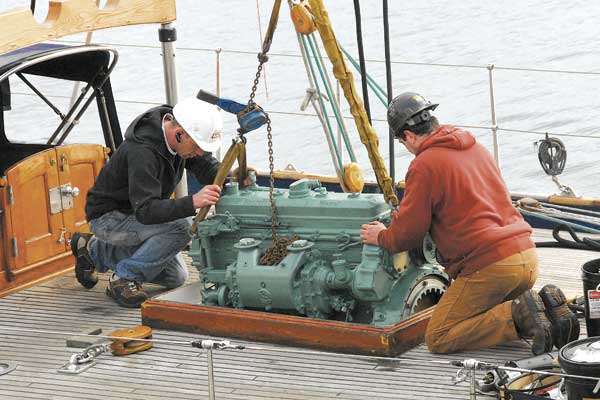
[caption id="attachment_3531" align="alignnone" width="300"] Superintendant Colin Spivey (left) from Intercon Marine, and Ray Goyette from Finning Canada, work to lower HMCS Oriole’s newly refurbished engine into the ship’s engine room.[/caption] At the end of a crane in HMC Dockyard, HMCS Oriole’s newly refurbished diesel engine hung like a 1.5 tonne piñata as it waited to be lowered into the berthed sailboat.It was a delicate job with only half an inch of clearance on either side of the hatch as it made its way into engine room.“The ship is moving in the water and the crane is static on the jetty, so it can be finicky work,” said Colin Spivey, a superintendent at Inercon Marine, who headed up the job. “If anything moves too much while we’re lowering the engine it could go very poorly.”Thanks to the cool heads and steady hands of his crew everything went as expected.The engine was removed a month ago and sent to Finning Canada in Saanich for an overhaul.“The engineers at Finning are comfortable working on our engine,” says LCdr Jeff Kibble, Oriole’s commanding officer. “They come down every once in a while to do maintenance work, so they’re the best people for the job.”This time last year Oriole experienced an extensive and complete refit. The engine was removed for general maintenance but LCdr Kibble says a refurbishment wasn’t on the books until now.“We kept running the engine for the next year and it was fine,” he says. “We started noticing a few issues here and there so we decided it was time.”The engine, a Detroit Diesel 671, received new cylinder linings, bearing, valves, vale springs, and a new crank.“They’re very reliable engines as long as you take good care of them,” says LCdr Kibble. “With the work that’s been done to it, we’ll be...

[caption id="attachment_3528" align="alignnone" width="300"] Twenty-four electrical students from Camosun College visited dockyard to see how an industrial workplace relates to their trade. Al Hall, work centre manager electrical, took the students on a tour of Fleet Maintenance Facility’s electrical shop.[/caption] Electrical students from Camosun College got an industry eye-opener March 8 when they visited Fleet Maintenance Facility (FMF) two weeks ago. A group of 24 second and third year electrical apprentices observed maintenance work at one of the largest industrial centres in Victoria – HMC Dockyard. The group was accompanied by their instructors Dan Daigle and John Bain, both former DND employees; Daigle with Base Construction Engineering (BCE) and Bain with FMF. “Victoria is not a very industrial town, so a lot of the things they see here at the base are unique,” said Daigle. “They see equipment we don’t have in other parts of Victoria, such as pumps built in the 1800s and the submarine batteries. They get an idea there is a lot more to the trade than just wiring a house.”The most impressive on the list of places visited were building D250, the corrosive fluid facility, weapons facility, the main electrical distribution control centre for Dockyard, the pump house and the first aid cell. “We teach them a lot of theory in class, but to see the equipment on the base and understand how it all fits together is extremely valuable,” said Bain. The glue that binds the myriad of work is management, and this did not go unnoticed by third year student Jocelyn Burton.“I was most impressed by the management on the base, and how everyone has a type of speciality and how it all comes together to achieve the overall goal,” she said.Student James McLaughlin, who works as an electrician in Port Hardy, found the...

[caption id="attachment_3517" align="alignnone" width="300"] Cpl Rick Ayer, Formation Imaging Services HalifaxMembers of the Naval Boarding Party from HMCS Regina, deployed in their Rigid Hull Inflatable Boat, approach a fishing dhow in the Arabian Sea during Operation Artemis.[/caption] After travelling 50,000 nautical miles for Operation Artemis, the ship, and air and naval crew of HMCS Regina are only four days away from being home and enjoying the hugs of loved ones. Hundreds of family and friends will line A jetty the morning of March 14 in anticipation of the warship’s return. The thrill of seeing the shoreline of Victoria, and the smiling faces of nearest and dearest is growing equally on board the ship.“We can’t wait to reunite with our families,” said Cdr Jason Boyd, Commanding Officer. “The atmosphere on the ship is one of absolute excitement.” It’s been eight months since the warship sailed from Esquimalt harbour on a mission to keep the Arabian Sea secure. The Canadian ship was part of a multi-national naval force - Combined Task Force 150 – tasked to monitor the area for troublesome activity. “Our economy floats on salt water and our mission was to promote security, sovereignty, and prosperity across the Arabian Sea, Indian Ocean, and Gulf of Oman,” explained Cdr Boyd in a phone interview. “These are some of the most important shipping lanes in the world. This involves keeping the sea lanes safe and preventing the shipping of illicit cargo.”While at sea in the operational area, Regina boarded and examined 19 vessels. Its embarked Sea King helicopter quickly became a familiar sight on the horizon, clocking 388 hours of air time. And the ship’s newsiest capability, the unmanned aerial vehicle (UAV) that was manned by four gunners and a small team of civilians was in the air for 545 hours to...

[caption id="attachment_3510" align="alignnone" width="300"] A/SLt Malcolm Gardiner, officer of the watch, is in charge of the safe movement of the ship. He fixes on a point to get a bearing on the pelorus.[/caption] Two weeks ago, officer of the watch A/SLt Matthew Noiles stood on the bridge of Patrol Training Craft Caribou 57, his eye level with the pelorus. “Recommend come left 20 degrees new course one zero zero at stationing speed,” he said to the Captain, LCdr Sam Patchell. LCdr Patchell assessed the speed and course recommended and responded, “Yes please.” The Orca class vessel then veered left in sync with the other five Orcas in the formation sailing off Esquimalt Harbour. This manoeuvre was part of a training exercise on Feb. 28 for junior officers, which involved the entire fleet of Patrol Craft Training vessels. For the junior officers it was a stressful time, as it tested the navigation and seamanship in the final stages of their Maritime Surface and Subsurface (MARS) training. If they misunderstood a signal and turned the wrong way they could easily have a collision between two ships. “Manoeuvring is about being a team within the ship,” says the course training officer, Lt(N) Travis Bain. “They need to use time-management skills, multitasking and have good direction to support the team. There is a lot happening at once.” Students have learned ship handling in the classroom and in the simulator, so during the exercise they had to receive signals and get the ship in formation safely while giving direction to the team and briefing the Captain. On board PTC Caribou, five MARS IV students were in the final stages of this intense sea phase training. Each rotated to different positions on the bridge and throughout the day took bearings to advise the captain on navigation....

[caption id="attachment_3507" align="alignnone" width="300"] Personnel Support Programs (PSP) fitness researchers observe a Canadian Forces volunteer perform the sandbag lift during the extensive development phase of the FORCE evaluation.[/caption] On April 1, 2013, the Canadian Armed Forces will implement the updated approach to military fitness: the FORCE Program. The new program has two components: the new fitness test, called the FORCE Evaluation; and the FORCE Exercise Prescription, the operational fitness training system available at www.DFit.ca. Replacing the 30-year-old Canadian Forces EXPRES Test, the FORCE Evaluation has been scientifically validated and developed specifically for the CAF by the Personnel Support Programs (PSP) Directorate of Fitness. Rather than testing fitness with the traditional push-ups, sit-ups, grip tests and endurance runs, the FORCE Program evaluates members’ ability to execute tasks that are directly linked to true-to-life physical challenges faced on operations. In a comprehensive analysis of military operational fitness, PSP human performance scientists and fitness experts have looked at more than 400 physical tasks performed by Canadian military personnel in all environments over the past 20 years.“I am extremely pleased with both the overhaul of the Canadian Armed Forces’ fitness evaluation system and the establishment of a common fitness standard,” said General Tom Lawson, the Chief of the Defence Staff. “The FORCE Program is not about training to pass a fitness test; it’s about training for the variety of military operations we are involved in. As members of the Canadian military, we never know where we may be called upon to serve, or what form that service will take. The FORCE Program will better help us prepare to meet our fitness readiness challenges head-on.”Four FORCE Evaluation components have been designed to accurately test CAF members’ ability to complete six common military tasks encountered on routine, domestic and expeditionary operations: escape to cover; picket and...
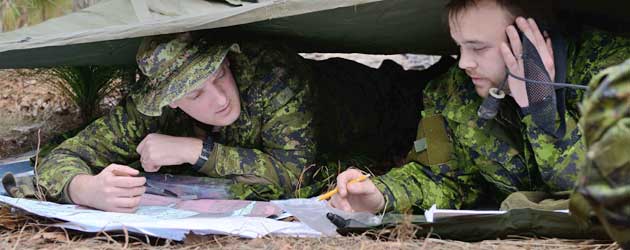
Captain Jeff Brownridge (left) and Bombardier Benjamin Marier (right), from Second Regiment Royal Canadian Horse Artillery, track a fire mission during Joint Operational Access Exercise in Fort Bragg, North Carolina.
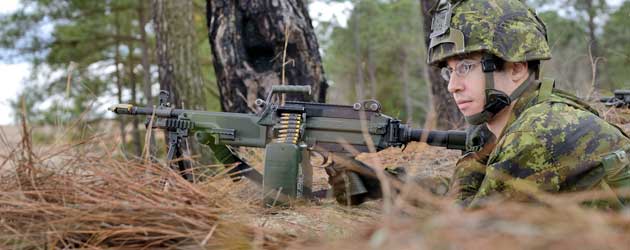
Private Tyson Morton from 3rd Battalion, The Royal Canadian Regiment, surveils the surrounding area from an observation post during Joint Operational Access Exercise in Fort Bragg, North Carolina.
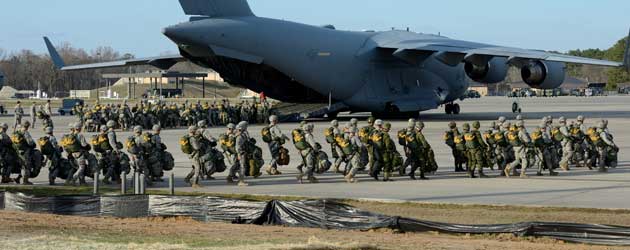
Members of 3rd Battalion, The Royal Canadian Regiment, along with hundreds of paratroopers from 82nd Airborne Division make their way to the waiting Canadian and American planes for the Joint Operational Access Exercise held at Fort Bragg, North Carolina.
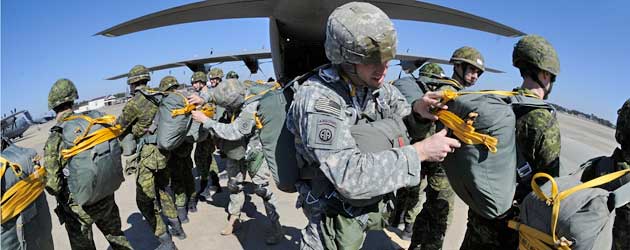
Members from the 3rd Battalion, The Royal Canadian Regiment have their parachutes inspected by members from the 82nd Airborne Division, 1st Brigade Combat Team prior to loading an aircraft at Pope Air Force Base during Joint Operational Access Exercise.
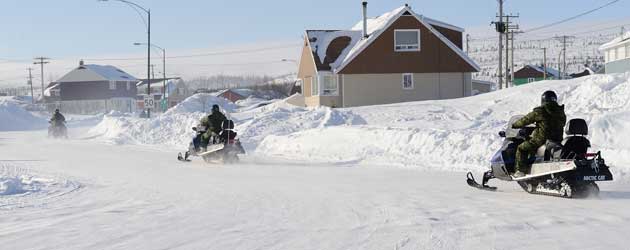
Members of C Company of 1 Royal 22e Régiment travel on snowmobiles in the streets of Schefferville, QC, during Exercise Guerrier Nordique. The exercise was designed to prepare soldiers for future operations in Northern Quebec.

A Griffon helicopter from 430 Tactical Helicopter Squadron participates in Exercise Guerrier Nordique, near Schefferville, QC. The exercise was designed to prepare soldiers for future operations in northern Quebec.

[caption id="attachment_3476" align="alignnone" width="300"] Mia Larsen has been a tailor for the Canadian Forces for 50 years. On Feb. 26 she received the Queen's Diamond Jubilee medal from Premier Christy Clark at the Empress Hotel for her lifetime contribution.[/caption] In 1963 Mia Larsen sewed her first stitch on a military uniform at a shop in Work Point. From that point until now, a 50-year span, she’s tailored thousands of uniforms and mounted hundreds of medals. In recognition of this dedicated service of ensuring military personnel look their best, she received the Queen’s Diamond Jubilee Medal from Premier Christy Clarke last Tuesday.“The fact that my staff thought enough of me to think I deserved this was very heart warming,” said Larsen. “I was shaking so hard I could hardly read the letter that came to my home, and after I read it I cried for a long time when I learned about receiving this medal.” Her three employees nominated her, feeling strongly that she fit the criteria of an outstanding, deserving individual.“We wanted to nominate Mia because she has been doing this so long and has mounted so many medals. We thought wouldn’t it be nice to see her issued one herself,” said long-time employee Donna Bird. Larsen still uses her original Singer sewing machine that is now 56 years old. “It is like everything else, if you look after it and take care of it, it will last you a lifetime,” she says. Five decades ago, 30-year-old Mia apprenticed with master tailor Margaret West.“She was a top-notch sewer and taught me everything I know.” Larsen bought the business 13 years later when West retired. Eventually the store moved from Work Point to its current CANEX location, and slowly Larsen began to hire staff to fill the demand.This summer, she’ll celebrate...

The OneMatch Cell and Marrow Network is holding a “swab drive” on Tuesday, March 12 between 9 a.m. and noon at CFB Esquimalt Chief and Petty Officers’ Mess in conjunction with the Blood Donor Clinic being held between 8 a.m. to 4:45 p.m. “CFB Esquimalt and the Department of National Defence as a whole have always been such fantastic supporters and contributors to the Canadian Blood Donor” said Cassandra DeLuca, coordinator for OneMatch, “and I’m sure CFB Esquimalt will do the same for OneMatch.”What is OneMatch?OneMatch is a program of the Canadian Blood Services (CBS) and is recognized and supported by the Surgeon General of the Canadian Forces Health Services. OneMatch recruits healthy volunteers to be put on a donor list for patients with diseases, such as leukemia and lymphoma, which inhibit the ability to produce stem cells. What are stem cells?Stem cells are immature, blood forming cells capable of developing into any cell.How do I become a potential donor?Becoming a potential donor is done with a simple cheek swab which collects a DNA sample. The information stored on the OneMatch registry provides a brief snapshot of the potential donor’s medical history with the privacy of the donor being protected. Who can donate? OneMatch will accept all healthy donors between the ages of seventeen and fifty years of age. Is there an ideal donor?Yes, studies have shown that the best stem cell donors, meaning better long-term survival rates, are young males between seventeen to thirty-five years of age. Presently only twelve per cent of the registry is from this target group. Young ethnic males are especially being sought after because a patient is most likely to find their donor from their own ethnic group.Can patients’ family members donate stem cells?Yes, but unfortunately fewer than thirty per cent of patients, who...

[caption id="attachment_3469" align="alignnone" width="300"] Cdr Paul Francoeur, Commanding Officer of HMCS Calgary, was true to his word. Wearing a Toronto Argonauts jersey and HMCS Calgary’s ball cap, he hoisted up the flag before the ship sailed past Duntze Head, honouring the Grey Cup debt between his ship and HMCS Toronto. Calgary iscurrently conducting sea trials.[/caption]When the final whistle blew in the CFL’s East and West finals, it was determined the Stampeders would meet the Argonauts in Skydome to compete for the 100th Grey Cup. In the spirit of sportsmanship, and in keeping with the finest traditions of the Royal Canadian Navy (RCN), a challenge was issued by the sailors of HMCS Calgary to the crew of HMCS Toronto. The challenge was to stop bailiffs from taking over the ships, which HMCS Toronto quickly accepted, proposed that the Captain of the ship who’s namesake city team lost the Grey Cup game would don the opposing team’s colours, and hoist their flag when the ship sailed. Such a challenge is by no means unprecedented, and the RCN has maintained close ties and has a long history with the CFL. Canadian warships proudly support their namesake city sports teams. The 1944 Grey Cup was actually won by an RCN team, when reserve sailors from HMCS Donnacona (Montreal-based) defeated the Hamilton Wildcats 7-6 at Civic Stadium (later Ivor Wynne) in Hamilton. So in the spirit of tradition, Cdr Paul Francoeur, Captain of HMCS Calgary, acknowledged the Toronto Argonaut’s 100th Grey Cup victory and honoured the ship’s debt to HMCS Toronto by proudly flying Argos colours as the ship sailed from Esquimalt Harbour last week. The crew of HMCS Calgary is looking forward to a win the 2013 CFL season, while sailors from HMCS Toronto sailors are hoping to repeat their 2012 success.HMCS Calgary

A soldier from Oscar Company, 3rd Battalion The Royal Canadian Regiment shows a thumbs up after completing his Helicopter Insertion Drill on a Blackhawk helicopter prior to Joint Operations Access Exercise in Fort Bragg, North-Carolina.
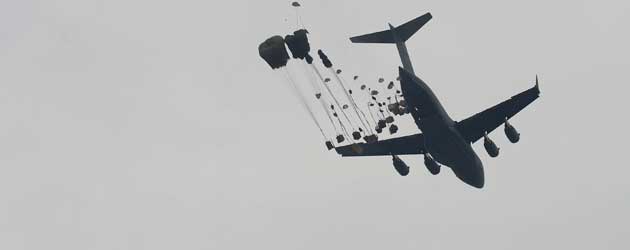
A Royal Canadian Air Force CC-177 Globemaster III completes a heavy equipment drop at the Sicily drop zone as part of the Joint Operational Access Exercise, being held at Fort Bragg, North Carolina.

Cpl Guillaume St-Cyr, of 2 Royal Canadian Horse Artillery, prepares to exit a C-17 mock up as part of the Basic Airborne Refresher (BAR) course during the Joint Operational Access Exercise (JOAX) at Fort Bragg, North Carolina.

Pte Trevon Best from 1st Battalion, The Nova Scotia Highlanders (North), provides cover for troops during the final assault scenario as part of Exercise Southbound Trooper XIII. More than 600 Canadian and US military personnel participated in the exercise from February 17-23.
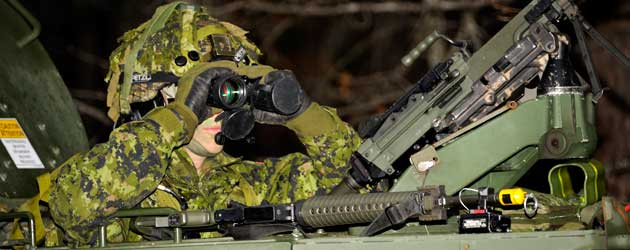
A soldier from 36 Canadian Brigade Group provides security for troops as they secure a village near his position during the final assault scenario as part of Exercise Sounthbound Trooper XIII. More than 600 Canadian and US military personnel participated in the exercise from February 17-23.

36 Combat Engineer Regiment, Halifax, initiates explosive training during Exercise Southbound Trooper XIII (Ex SBT XIII) at Fort Pickett, VA. More than 600 Canadian and US military personnel participated in the exercise from February 17-23.

[caption id="attachment_3431" align="alignnone" width="300"] Last week, Peter MacKay, Minister of National Defence, announced plans to replace the existing A and B jetties in CFB Esquimalt’s dockyard.[/caption] With the grey hulls of naval warships looming in the background, Minister of National Defence Peter MacKay stood before base civilian and military personnel assembled on A jetty and announced a major project for the betterment of the navy. Both A and B jetty will be replaced by a more sophisticated berthing system. The project will cost between $430 and $530 million, and will create an estimated 1,400 local jobs.“The government has already awarded two design contracts to AMEC of Halifax and Stantec Consulting of Vancouver. It will be very good news for the workers and businesses in the community,” said Minister MacKay. “Esquimalt and the surrounding region will see significant economic benefits from this project when it’s fully underway.” Once completed, the project will provide berthing space for four frigates, two Arctic offshore patrol vessels, one auxiliary oiler replenishment ship and two submarines.Fleet and warship size have outgrown the existing jetties.New steel and concrete pile jetties will replace the existing treated wood jetties that were originally built in the 1940s and have reached the end of their life.This project will also replace electrical wiring and telecommunications cables in order to meet modern standards.Design for the new jetties is expected to be ready in 2014 with construction to follow after the tender process is completed.In anticipation of this work, and to enhance habitat diversity, CFB Esquimalt constructed a series of underwater artificial reefs within the western entrance of the harbour in conjunction with Fisheries and Oceans in 2012. This infrastructure work represents phase two and three of a three-phased project. In June 2012 a construction contract valued at $19.7 million was awarded to Scansa Construction...

[caption id="attachment_3428" align="alignnone" width="300"] PO2 Bruce Bevil and barber Scott Attrill of Floyds Barber shop arm themselves with scissors in anticipation of cutting Jenna Boon’s hair. On March 22, providing $5,000 is raised for Sailors for a Cure, her long locks will come off during a head shave at Floyds. Funds raised during this event will support Ronald MacDonald house and children with cancer as part of Sailors for a Cure.[/caption] Even though Jenna Boon has been growing her long black locks for 26 years, she’s agreed to shave it all off at the skillful hands of Floyds barber Scott Attrill – that’s if base personnel can raise $5,000. The Base Duty Watch Coordinator agreed to undergo the clippers in support of Sailors for a Cure, a charity set up by PO2 Bruce Bevil on behalf of his sister-in-law Sandra Bevil who battled breast cancer.“Honestly, I didn’t have to think about it that long to tell him yes I will do it,” says Boon. “I think it’s a good cause. And it’s making an important statement that we can be beautiful with or without hair.”Her hair will be donated to Locks of Love, a company that makes wigs out of natural hair for cancer survivors. Monetary funds raised will go to the Ronald MacDonald House of B.C. in support of children with cancer.This year’s target is $50,000, including the $5,000 base goal. People can donate for both the overall campaign, or towards Boon’s head shave through www.sailorsforacure.com. Anyone wanting to witness the haircut should pop by Floyds on March 22 at 10 a.m. Sailors for a Cure began in 2003 when PO2 Bevil was deployed in HMCS Calgary and learned his sister-in-law had breast cancer.He wanted to help and asked his shipmates to take part in Operation Q-ball, an initiative...

[caption id="attachment_3425" align="alignnone" width="300"] Left to right, LS Jason Rupke, Lt(N) Peggy Kulmala and SLt Devin McCormick take pledges at the Heroes Panel phone lines.[/caption] For 47 years, television viewers have tuned in to watch the Variety Show of Hearts Telethon showcasing internationally renowned entertainers.Last weekend, viewers also saw 10 Canadian naval reservists from Victoria’s HMCS Malahat and Vancouver’s HMCS Discovery sitting on the telethon’s Heroes Panel taking pledges on the phone in Coquitlam B.C.“While on the phone, we had a chance to talk to donors and hear their stories,” said Malahat public affairs officer, Lt(N) Peggy Kulmala. “I was humbled to not only receive thanks for what we did supporting children with special needs in B.C., but thanks for my service to Canada and Canadians.” The request for naval reserve involvement stemmed from Malahat’s longstanding support to Variety’s Boat for Hope in Victoria. Malahat has been supporting this community event since its inception in Victoria eight years ago.Boats For Hope is held on the first Saturday in June. Each year, more than 250 children, many with special needs, and their siblings and parents have embarked on boats of all shapes and sizes from Malahat jetties for a fun-filled tour of Victoria’s Inner Harbour. -Shelley Lipke, Staff Writer
Register today and start training. Do it because you can!

Find the collectable Roger’s Chocolate HMCS Rainbow Tin and Canadian Navy Chocolate Bar at CANEX outlets.